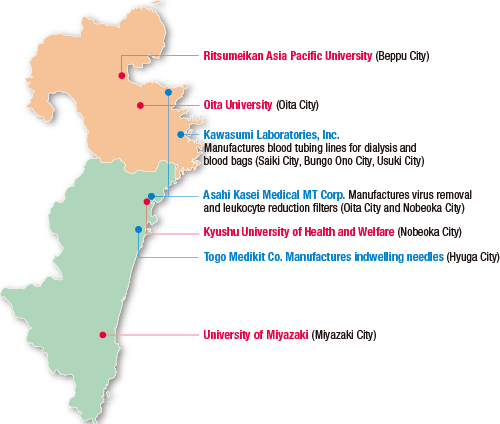Home > Highlighting JAPAN > Highlighting Japan October 2016 > Kyushu Calling
Highlighting JAPAN

Eastern Kyushu Medical Valley
Government, academia and industry have come together in eastern Kyushu to establish a “Medical Valley” that will improve medical care — particularly in the field of blood medicine — far behind the island’s shores.
Miyazaki and Oita Prefectures in eastern Kyushu are home to a number of leading manufacturers of medical instruments in the field of blood medicine. Among them, Asahi Kasei Medical MT Corp., the global market leader in the manufacture of the blood purifiers used in kidney dialysis and the virus removal and leukocyte reduction filters used for blood transfusions, has five factories in Oita and Nobeoka, Miyazaki Prefecture. Togo Medikit Co., Japan’s market leader in the production of the indwelling needles used for dialysis and infusion, has three factories in Hyuga, Miyazaki Prefecture. Kawasumi Laboratories, Inc., which manufactures extracorporeal tubing lines for dialysis and blood bag products, in which latter field it is Japan’s leading supplier, has three factories in Oita.
In addition to commercial enterprises, the two eastern Kyushu prefectures are home to institutes of higher education that engage in the research and development of medical technology, including Ritsumeikan Asia Pacific University, Oita University, the University of Miyazaki and Kyushu University of Health and Welfare.
Focusing on these strengths, Miyazaki and Oita Prefectures have jointly developed the Eastern Kyushu Medical Valley Framework, through which the prefectural governments aim to create four medical industry hubs; namely, for research and development, for the training of skilled medical workers, for blood related medicine, and for the medical instrument industry.
“By establishing these four hubs, we will accumulate a wide range of medical industries and activate the economy of eastern Kyushu,” says Kenji Kawauchi of Miyazaki Prefecture’s Industrial Cluster Promotion Office. “We will also contribute to Asian countries through our medical technologies.”
There is increasing demand for advanced medical technologies in Asian countries whose economies continue to grow. Miyazaki and Oita are paying particular attention to Thailand, a center for so-called medical tourism because the country’s standard of healthcare is comparatively high among ASEAN countries.
Thailand presently has no equivalent to the position of clinical engineer in Japan. In Japan, clinical engineers are qualified through national exams to operate, maintain and inspect medical devices for blood dialysis and assisted respiration. For dialysis treatment, they are authorized to insert and remove needles. In Thailand, on the other hand, the staff in similar positions are not allowed to touch patients, with physicians and nurses exclusively having this authority. The absence of qualified clinical engineer staff can lead to the improper management, maintenance and inspection of medical instruments.
In this context, in 2013, industry, academia and government entities came together in Miyazaki and Oita to commence training focused on dialysis-related medical technology as part of medical technology personnel development, while inviting physicians specializing in nephrology, dialysis nurses and engineers from Thailand. The aim of the training is to improve the participants’ dialysis skills and teach accurate methods of operating, maintaining and inspecting medical devices through lectures, practical training and visits to companies and hospitals. In total, thirty-seven Thai participants have visited Japan to date.
“The participants were impressed by the high level of dialysis skills and efficiency at the hospitals in Japan,” says Kawauchi. “They also admired how the Japanese medical companies controlled safety and hygiene at the medical equipment manufacturing sites.”
A hub is now being established in Thailand in which Kyushu University of Health and Welfare will provide support to a medical device training center to be opened at Thammasat University in 2017 by donating medical instruments and dispatching teachers. Related parties are also discussing future support for the establishment of the qualification system for clinical engineers in Thailand.
Under the Eastern Kyushu Medical Valley Framework, the development of new medical devices is being promoted alongside the above contributions to Asia. One such piece of equipment is the automated phlegm suction device that was jointly developed by Kyushu University of Health and Welfare and a medical device manufacturer. Conventional phlegm suction devices require doctors to momentarily remove a patient’s artificial respirator during medical procedures, placing a burden on patients and doctors alike. The new automated phlegm suction device, which eliminates this need, will be commercialized next year.
“Asian countries other than Japan will face a rapid conversion to an aging society in the future,” says Kawauchi. “The demand for new medical technologies from eastern Kyushu is expected to continue to grow.”

© 2009 Cabinet Office, Government of Japan







